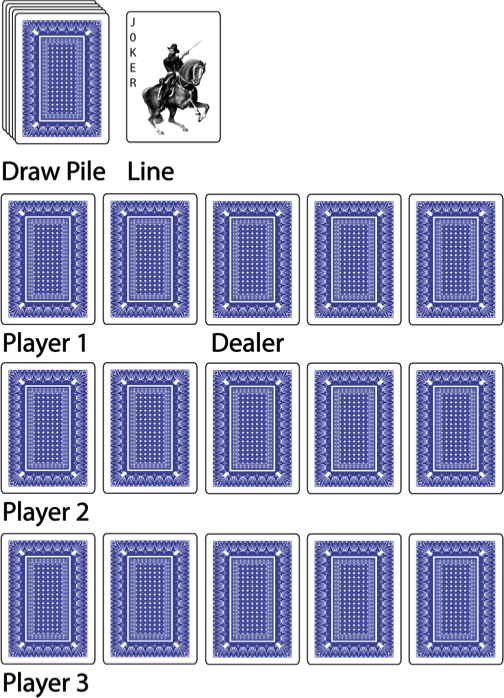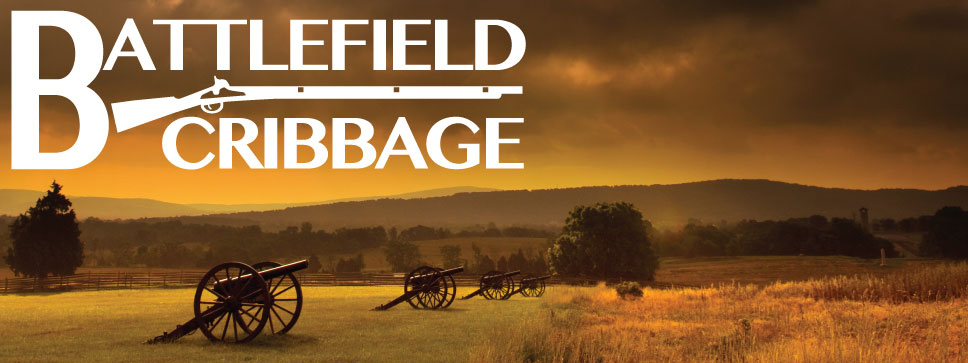Playing a Game
Play Overview
The play consists of a series of rounds, which are made up of multiple individual turns.
There are two ways to score during the game:
The first is called “Scoring the Line” that occurs during an individual turn, also called “Pegging”. Players score points, for runs, pairs, and combinations of runs and pairs as they discard on the line.
The second is called ‘Scoring the Round’, which occurs at the end of the round, when each player scores their hand. Scoring starts to the player left of the dealer and passes to the left. Each player scores the best 4 out of 5 cards in their hand in conjunction with a common card. The unused card goes to the dealers crib, which is a second hand for the dealer. The dealer scores the crib after scoring their hand.
There are two ways to score during the game:
The first is called “Scoring the Line” that occurs during an individual turn, also called “Pegging”. Players score points, for runs, pairs, and combinations of runs and pairs as they discard on the line.
The second is called ‘Scoring the Round’, which occurs at the end of the round, when each player scores their hand. Scoring starts to the player left of the dealer and passes to the left. Each player scores the best 4 out of 5 cards in their hand in conjunction with a common card. The unused card goes to the dealers crib, which is a second hand for the dealer. The dealer scores the crib after scoring their hand.
The Kill Card
BFC, unlike standard cribbage, also puts a joker into play. The joker is called the ‘kill card’ for it kills any hand that it is part of during the scoring of the round.
Play a Round
A round begins with a shuffle of the cards and a deal. Round play starts with the player to the left of the dealer in playing their turn. Instructions for playing a turn will be discussed in the next section. At the completion of a turn play passes to the left. Players will continue to play turns until one player reveals all five of their cards face up as a result of their turn, or until there are only two cards remaining in the draw pile. At the end of the round players will score their hand, with the dealer also scoring the crib.
Play a Turn
Take a Turn
The turn begins by choosing between taking a card from the draw pile or picking up at the end card on the line. The turn ends when a card is placed on the end of the line and earned pegging points are scored, called ‘scoring the line’. Scoring of the line is outlined in the next section.
The first turn of the round for each player is a special case. Before taking their first turn the player choses any two of the five cards in front of them and turns them face-up.
The first turn of the round for each player is a special case. Before taking their first turn the player choses any two of the five cards in front of them and turns them face-up.
Example - Starting a Player’s First Turn
Player 1 dealt. Player 2 begins their turn by turning over any two cards in their hand, exposing the 10s and the 5d. Now they will play the rest of the turn as normal.
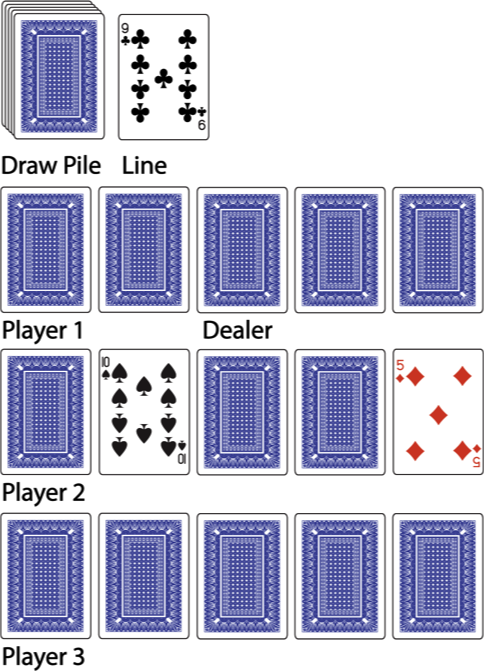
Choosing from the Draw Pile
If the card is selected from the draw pile, the card is revealed and the player makes a decision to replace a card in their hand, or to place it face up on end of the line. Any card in the player’s hand may be replaced, whether it is face-up or face-down. If the player decides to keep the draw card, it is placed face-up in their hand. The replaced card is then put face-up on end of the line. If the player does not wish to replace a card in their hand, they may directly place the draw card face up on end the line. The line is scored with the points pegged on the board. The player’s turn is complete and play passes to the left.
Example - Playing a Card from the Draw Pile
Continuing from the previous example, Player 2 completed their turn by choosing to take a card from the draw pile, which was the Qd. They decided to keep the card for their hand and then choose to replace a down card, though they could chose any card in there hand to replace. The 3s was revealed and placed on the end of the line.
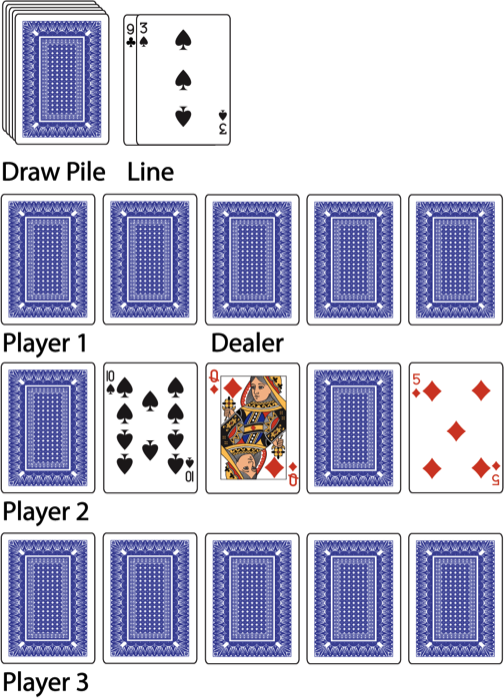
Choosing from the Line
If the card at the end of the line is chosen, the player must replace one of the cards from their hand. The card being replaced can be any card, face up or face down. The card from the line is placed face up in the hand. The replaced card is then placed face-up on end the line. The line is scored and earned points, if any, are pegged on the board. The player’s turn is complete and play passes to the left.
Example - Playing a card from the Line
Continuing from the first example (an alternate to the second example). Player 2 completed their turn by choosing to take a card from the end of the line, which is the 9c. They decided to keep the card for their hand and then choose to replace a down card with the 9c. The 8s was revealed and placed on the end of the line.
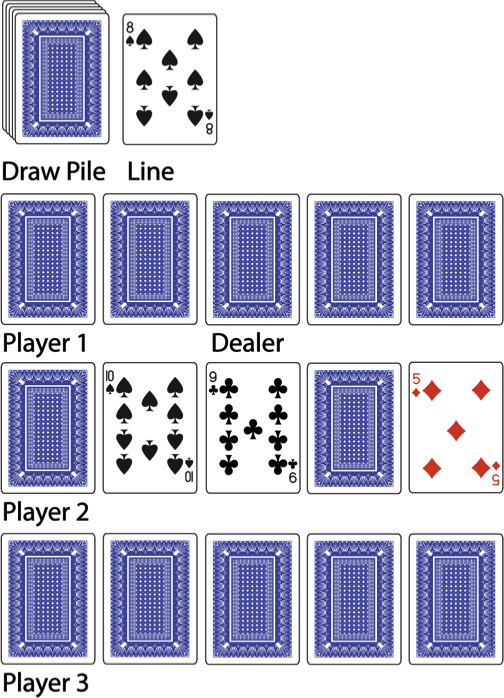
“Go” and Renewing of the Line
Whenever a card is placed on the end of the line that causes the sum of the line to exceed 31 points, the player removes the existing cards in the line by placing them face down out of play, and renews the line by placing the new card on the table. The player pronounces a ‘go’ and the player to the right scores one point. The player renewing the line does not score any points. Once the cards in the line go out of play no player may look at the cards for the duration of the game.
Example - Renewing the Line
At the end of a turn a player was placing the 4h on the line. The sum of the line is 29 without the 4. Adding the 4h causes the line to exceed 31; therefore the existing line was removed and replaced by the 4h.
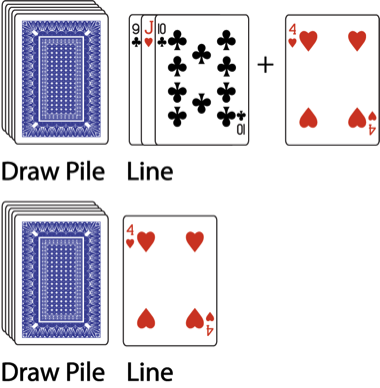
Ending a Standoff
Occasionally, a standoff occurs when players cycle through the same cards during a round by only playing the card at the end of the line and the cards that are face up in their hands. During a standoff the same cards that are face up cycle through with no points scored. At the end of the second cycle of playing through all the same cards the dealer must break the standoff during their turn by choosing to either draw from the draw pile, or use the card at the end of line to replace a card that has not been played in the standoff before.
Example - Standoff
Player 1 wants the 7c from Player 2 so on their turn they pick up the 3c off the line and replace the 3h, thinking Player 2 will give up the 7-h because they need the 3h in order to build their hand. Player 2 does not want to give Player 1 the 7h, so they pick up the 3c off the line and plays the 3s. Player 1 picks of the 3s and the players continue to swap 3’s off the line. After the second cycle the same cards being played Player 2, the dealer, must to draw a card from the draw pile or play a different card on the line, not a 3.
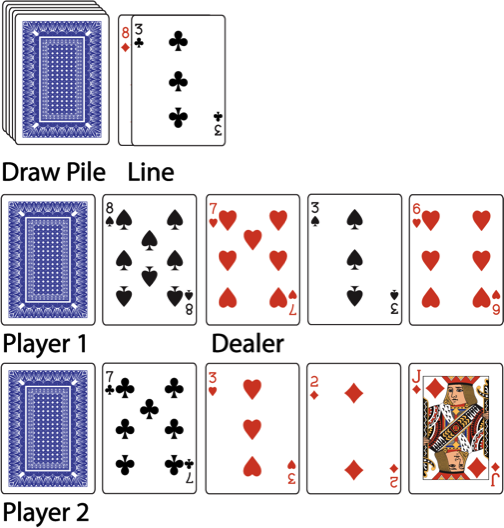
Cease Fire
In the case when a round is dealt the joker is the placed at the beginning of the line the round is immediately over with dealer proclaiming a ‘cease-fire’. All the players will then turn all the cards in their hand face up. Each player in order, starting to the left of the dealer, will then score their hand using the five cards. The common card, which is the joker, is not used in the scoring. The crib is not scored.
Example - Cease Fire
As Player 2 completed the deal the joker turned up as the card on the beginning of the front line. Player 2 calls a ‘cease-fire’. All the players turn up the cards in front of them. In order, the players score their cards starting with Player 3 (i.e. the person to the left of the dealer). The card in the crib is discarded.
